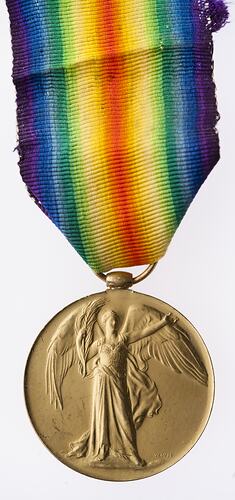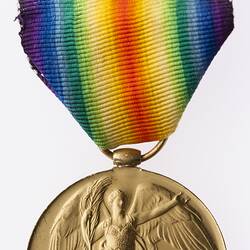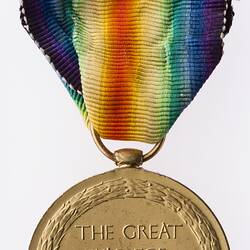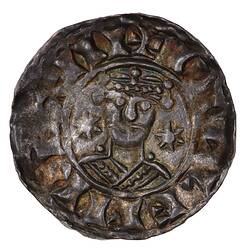Summary
Victory Medal 1914-1919 with ring mount and ribbon awarded to A-Sgt. William Marcus Osborne, service number 13922, 4 D.S.C., A.I.F.
A-Sgt Osborne was born in London and was a railway employee (engine driver) when he joined on 20 September 1916 aged 30 years 7 months. He married, Mrs Ruby Osborne and lived at 29 Moorhouse St, East Camberwell. Osborne embarked from Melbourne on 23 December 1916 on RMS Orontes. He was a mechanical transport driver with 9 ASC 17 Divisional Supply Column 300 Company in England and France. A-Sgt Osborne was discharged due to subacute nephritis, on 6 December 1918.
The Victory Medal was authorised in 1919 and was awarded to army, navy and air force personnel who served in a theatre of war between midnight 4th-5th August 1914 and midnight 11th-12th November 1918. The Allies resolved that, if they wished to issue a Victory Medal, it would share a common feature of a depiction of Victory on the obverse and a ribbon of red, yellow, green, blue and violet merged into a rainbow pattern. This medal, that of Great Britain, was awarded to personnel from countries in the British Empire (some 5,725,000 were issued). The other Allied countries that issued Victory medals were: Belgium, Brazil, Cuba, Czechoslovakia, France, Greece, Italy, Japan, Portugal, Romania, Thailand, Union of South Africa and the United States of America.
Obverse Description
Figure of Victory facing three-quarters right with wings spread; in her right hand she holds a palm branch, her left hand is extended and open. The artist's initials, W.McM. (W. McMillan) are above the ground line on the right.
Reverse Description
The words, 'THE GREAT . WAR FOR . CIVILISATION 1914 - 1919' within a circular wreath of laurel.
Edge Description
Text; '13922 A-SGT. W.M. OSBORNE 4 D.S.C. A.I.F.'.
More Information
-
Collecting Areas
-
Date Issued
1919 AD
-
Issued By
-
Mint
-
Artist
-
Awarded To
Sergeant William M. Osborne, Australia, 1919
13922 A-Sgt W.M. Osborne, 4th D.S.C., A.I.F. -
Inscriptions
Obverse; 'W.McM.' (W. McMillan - artist). Reverse; 'THE GREAT . WAR FOR . CIVILISATION 1914-1919'. Edge; '13922 A-SGT. W.M. OSBORNE 4 D.S.C. A.I.F.'.
-
Material
Bronze
-
Axis
12
-
Classification
-
Category
-
Discipline
-
Type of item
-
Overall Dimensions
50 mm (Height), 36 mm (Outside Diameter)
Height to top of ring.
-
Shape
Round with loop and ribbon
-
References
References: National Archives of Australia, B2455 World War One service records [Link 1] [Link 2]
[Book] Joslin, E C., et al. 1988. British Battles and Medals., 230-1 Pages
-
Keywords






